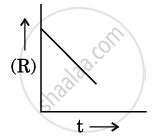Advertisements
Advertisements
प्रश्न
Why can we not determine the order of a reaction by taking into consideration the balanced chemical equation?
उत्तर
Balanced chemical equation often leads to incorrect order or rate law. For example the following reaction seems to be a tenth order reaction.
\[\ce{KClO3 + 6FeSO4 + 3H2SO4 -> KCl + 3H2O + 3Fe2 (SO4)3}\]
This is actually a second order reaction. Actually the reaction is complex and occurs in several steps. The order of such reaction is determined by the slowest step in the reaction mechanism. Order is determined experimentally and is confined to the dependence of observed rate of reaction on the concentration of reactants.
APPEARS IN
संबंधित प्रश्न
For a chemical reaction R → P, the variation in the concentration (R) vs. time (t) plot is given as:

(i) Predict the order of the reaction.
(ii) What is the slope of the curve ?
(iii) Write the unit of rate constant for this reaction.
From the rate expression for the following reaction, determine the order of reaction and the dimension of the rate constant.
\[\ce{H2O2_{( aq)} + 3I^-_{( aq)} + 2H^+ -> 2H2O_{(l)} + I^-_3}\] Rate = k[H2O2][I−]
Consider the reaction A ⇌ B. The concentration of both the reactants and the products varies exponentially with time. Which of the following figures correctly describes the change in concentration of reactants and products with time?
In any unimolecular reaction:
(i) only one reacting species is involved in the rate determining step.
(ii) the order and the molecularity of slowest step are equal to one.
(iii) the molecularity of the reaction is one and order is zero.
(iv) both molecularity and order of the reaction are one.
For which type of reactions, order and molecularity have the same value?
Why is the probability of reaction with molecularity higher than three very rare?
Why molecularity is applicable only for elementary reactions and order is applicable for elementary as well as complex reactions?
A catalyst in a reaction changes which of the following?
If the 0.05 molar solution of m+ is replaced by a 0.0025 molar m+ solution, then the magnitude of the cell potential would be
At concentration of 0.1 and 0.2 mol L–1 the rates of deem position of a compound were found to be 0.18 and 0.72 mol L–1 m–1. What is the order of the reaction?
